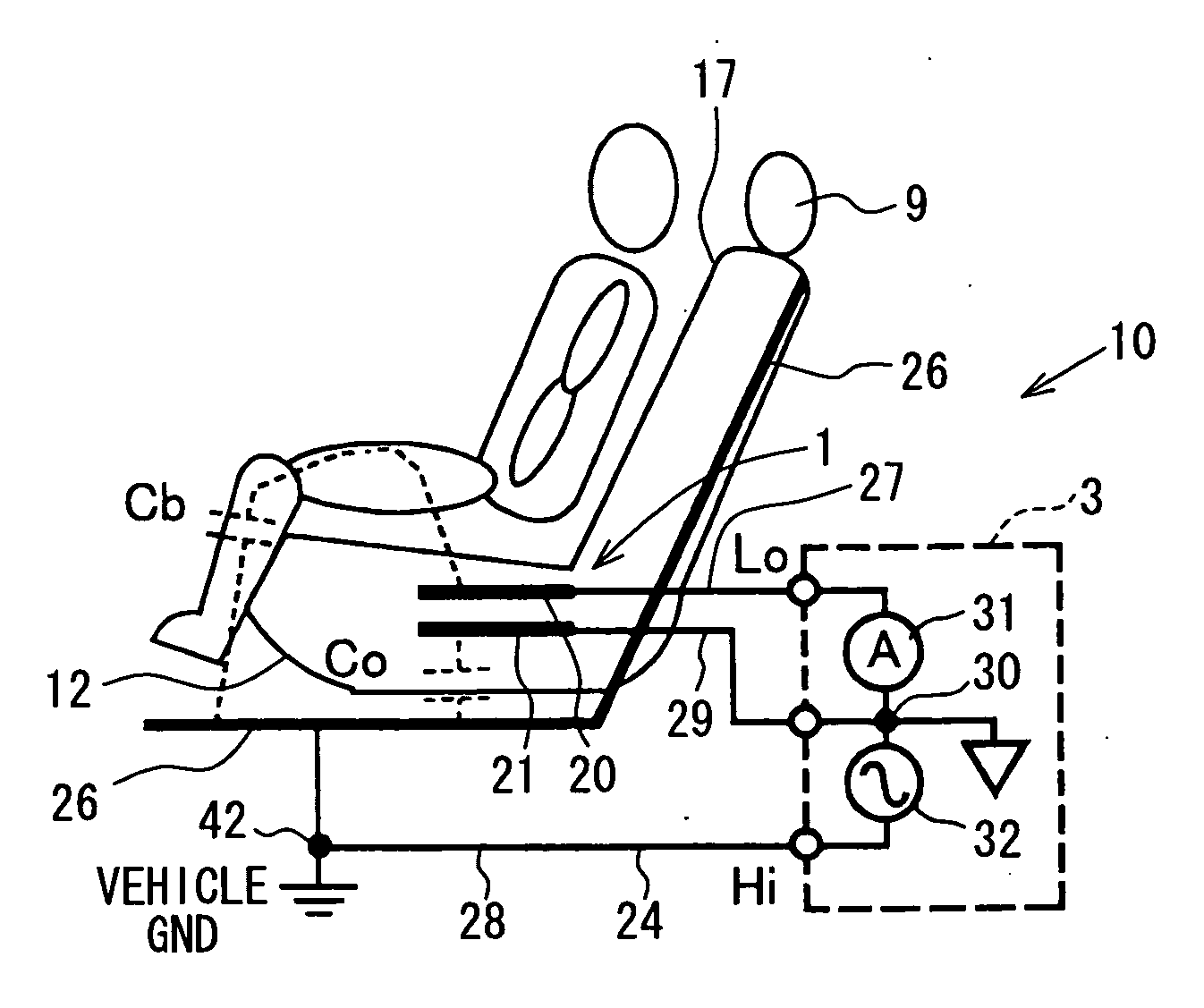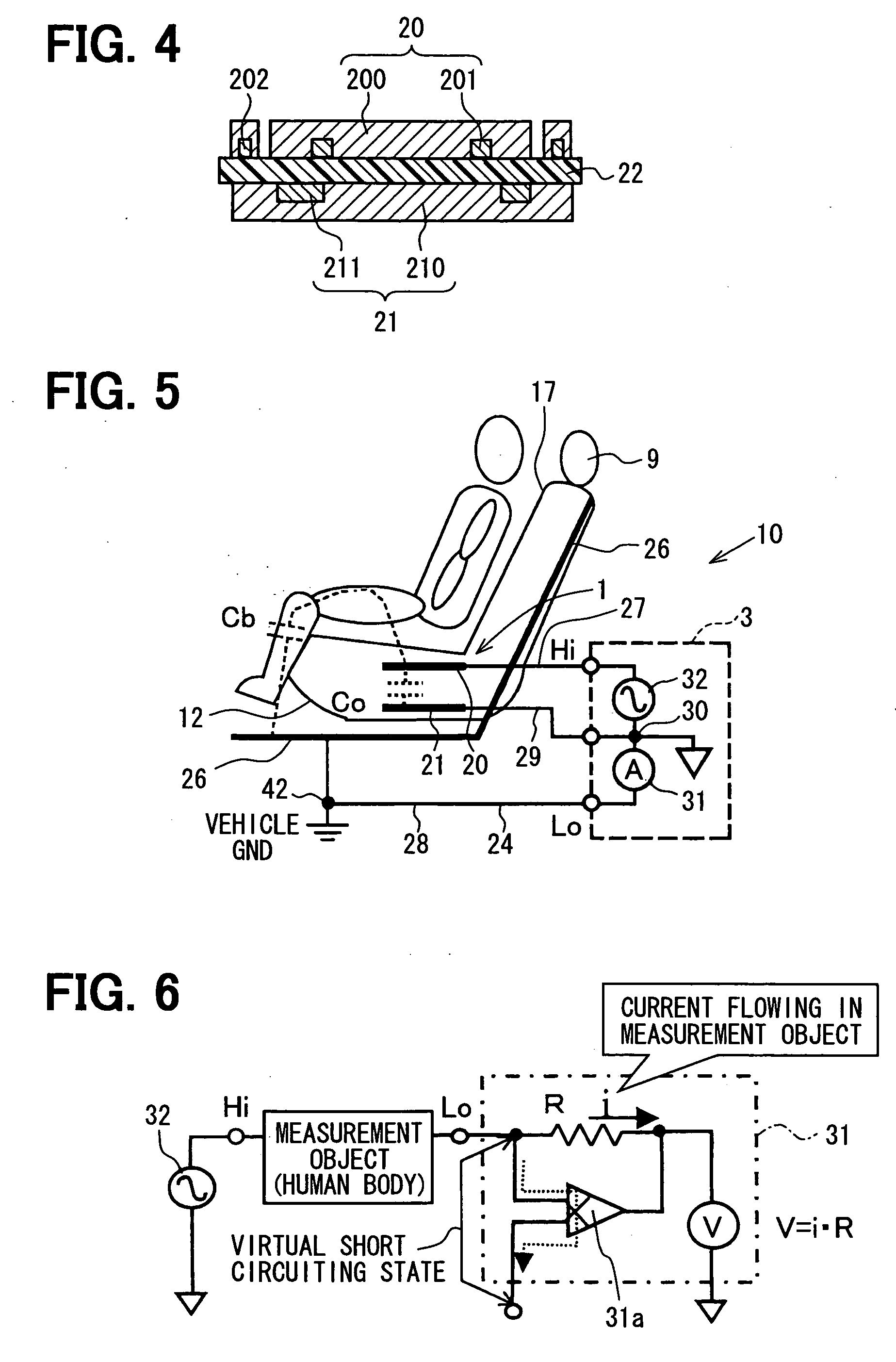Capacitance-based sensor and occupant sensing system
a sensor and occupant technology, applied in the field of capacitance-based sensors and occupant sensing systems, can solve the problems of large increase in factory work load, inability to cover various seating patterns of occupants, and inability to deploy air bags, etc., to achieve the effect of improving the level of accuracy in the determination of occupants
- Summary
- Abstract
- Description
- Claims
- Application Information
AI Technical Summary
Benefits of technology
Problems solved by technology
Method used
Image
Examples
first embodiment
[0054]FIG. 1 is a diagram showing an overall structure of an occupant sensing system having a capacitance-based sensor 10 according to a first embodiment. FIG. 2 is a diagram showing a front passenger seat 9 to indicate an installation position of an electrode unit 1, which serves as a sensing device of the capacitance-based sensor 10.
[0055] As shown in FIG. 1, the capacitance-based sensor 10 of the present embodiment includes an occupant sensing electrode 20, an empty seat capacitance reducing electrode 21, an electric current sensing device (an electric current sensing circuit) 31 and a drive device (a drive circuit) 32. The occupant sensing electrode 20 is embedded in at least one of a seat bottom 12 and a seatback 17 of the front passenger seat 9, which serves as a vehicle seat of the present invention. In this particular embodiment, as shown in FIG. 1, the occupant sensing electrode 20 is embedded in the seat bottom 12. The empty seat capacitance reducing electrode 21 is oppos...
second embodiment
[0068] As shown in FIG. 5, a second embodiment is characterized in that the drive device 32 is electrically connected between the occupant sensing electrode 20 and the empty seat capacitance reducing electrode 21 at the depicted position (the first position of the present invention), and the electric current sensing device 31 is electrically connected between the vehicle GND 42 and the empty seat capacitance reducing electrode 21 and the drive device 32 at the depicted position (the second position of the present invention).
[0069] Operation of each part of the capacitance-based sensor 10 at the time of measuring the capacitance will be described with reference to FIG. 5. When the drive device 32, which is connected between the occupant sensing electrode 20 and the empty seat capacitance reducing electrode 21, generates the drive output of the high-frequency, low-voltage, the occupant sensing electrode 20 is driven to have a high electric potential. In this way, the capacitance Cb i...
third embodiment
[0071] A third embodiment is characterized in that the structure of the first or second embodiment is modified as follows. That is, as shown in FIG. 6, the electric current sensing device 31 has an operational amplifier 31a, which keep the same electric potential and electric insulation between the corresponding two electrodes, between which the electric current sensing device 31 is interposed. In this way, in the structure (the first embodiment) where the electric current sensing device 31 is connected between the occupant sensing electrode 20 and the empty seat capacitance reducing electrode 21, these electrodes 20, 21 can be made in the state (the virtual short-circuiting state) where the same electric potential and the electric insulation are effectively provided between the electrodes 20, 21 by the operational amplifier 31a. In this state, a voltage drop V caused by a resistance R is measured with a voltmeter. Based on the relationship of V=i·R, the electric current i, which fl...
PUM
| Property | Measurement | Unit |
|---|---|---|
| dielectric constant | aaaaa | aaaaa |
| dielectric constant | aaaaa | aaaaa |
| capacitance | aaaaa | aaaaa |
Abstract
Description
Claims
Application Information
 Login to View More
Login to View More - R&D
- Intellectual Property
- Life Sciences
- Materials
- Tech Scout
- Unparalleled Data Quality
- Higher Quality Content
- 60% Fewer Hallucinations
Browse by: Latest US Patents, China's latest patents, Technical Efficacy Thesaurus, Application Domain, Technology Topic, Popular Technical Reports.
© 2025 PatSnap. All rights reserved.Legal|Privacy policy|Modern Slavery Act Transparency Statement|Sitemap|About US| Contact US: help@patsnap.com



